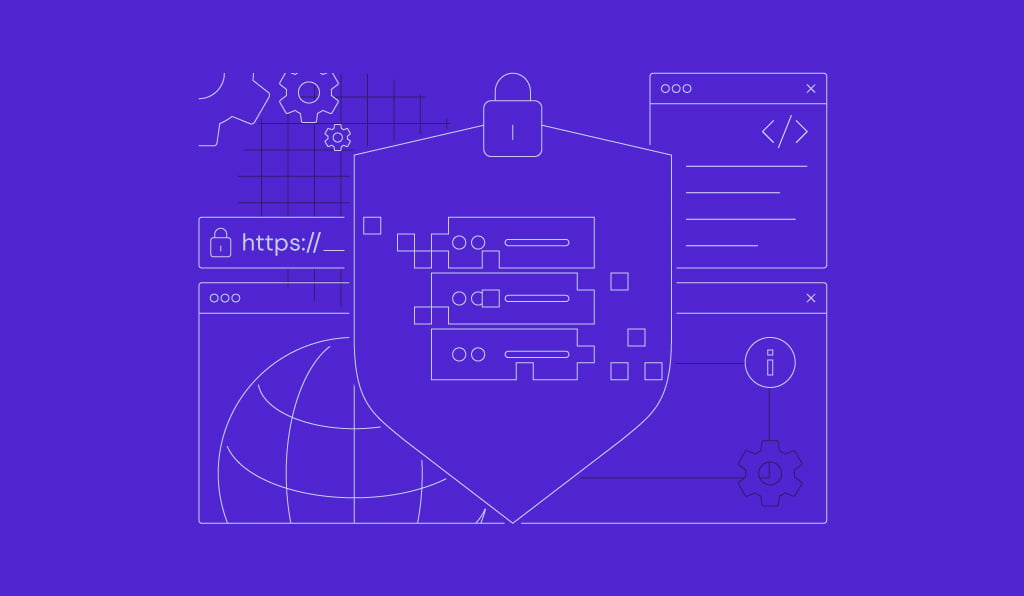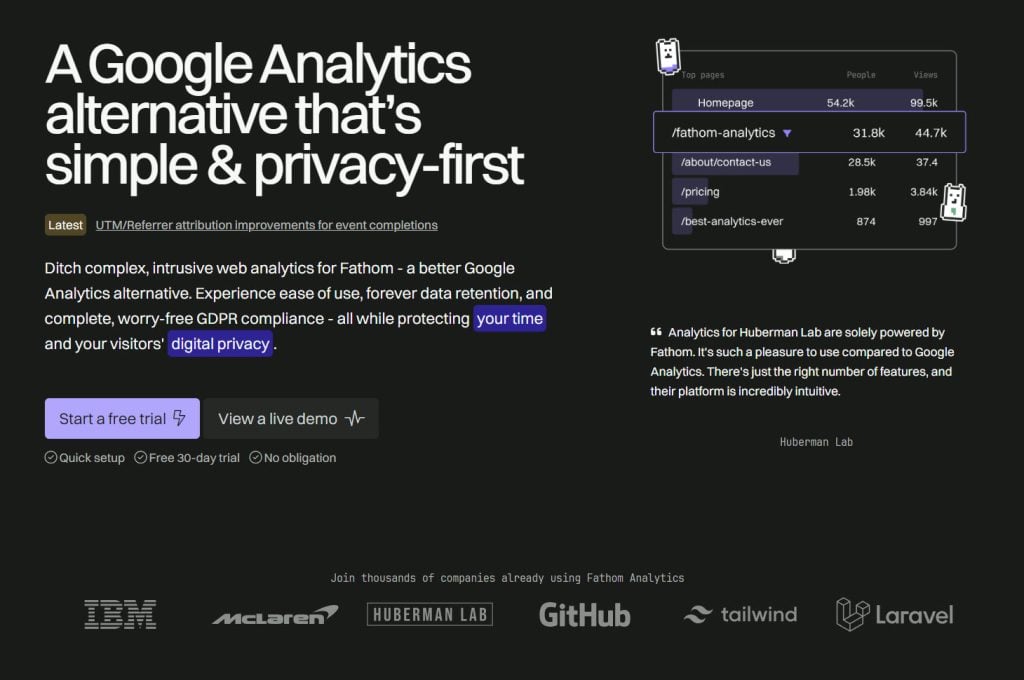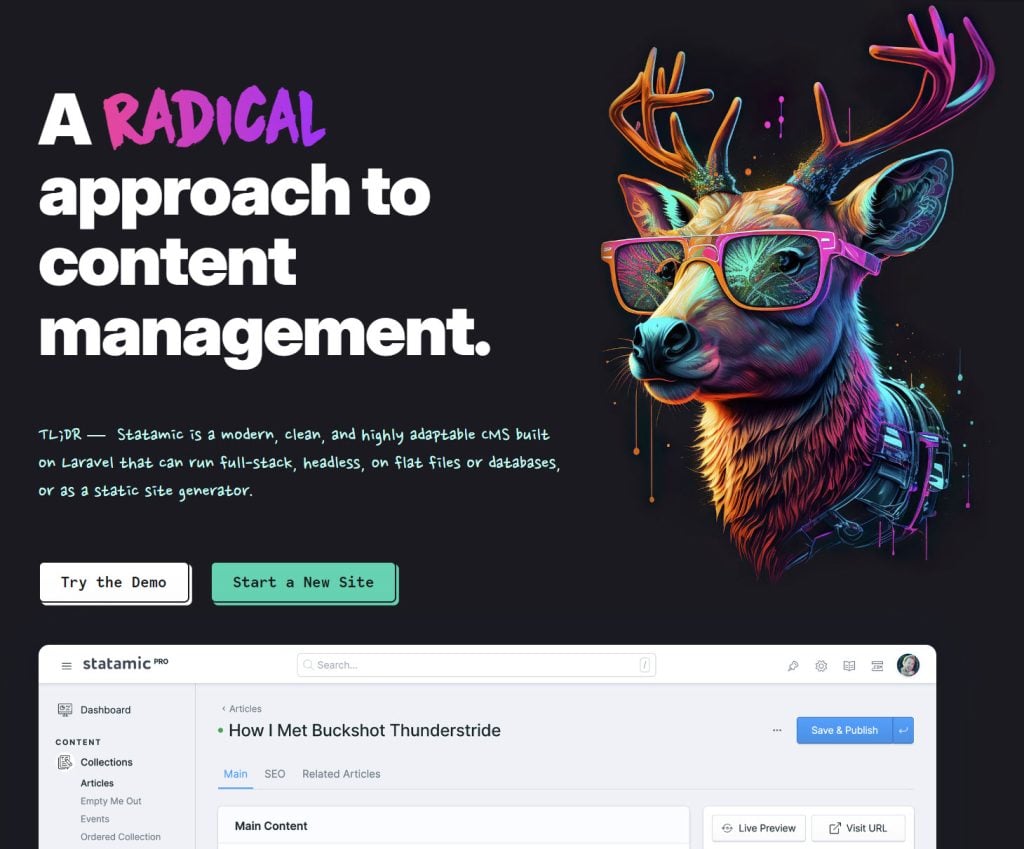What is Laravel: core features, use cases, and advantages of the PHP framework

Laravel is a web application framework designed to streamline web development. Thanks to its comprehensive starter kits, it’s quick and easy to set up, even for beginners.
Though primarily a back-end framework, you can use Laravel for full-stack development in PHP, creating React or Vue front-end systems, and as a back-end API.
In this article, we’ll explain the relationships between Laravel’s key components and provide real-life use cases. We’ll also go over the benefits of using Laravel and how it compares against some of its competitors.
How Laravel works:
Laravel follows the Model-View-Controller (MVC) design pattern, which separates the application logic into three main components:
- Model – manages data and business logic.
- View – handles the presentation layer.
- Controller – acts as an intermediary between the model and the view, processing user input and returning responses.
Let’s take a look at how they make Laravel work and connect with other system and modules.
The controller gets data from the model and sends it to the view. Laravel uses a simple system to link URLs to specific controllers or actions. Web requests are directed to the right controller methods by routes, which then work with models and views.
You can add middleware functions to routes to handle tasks like logging activities for future debugging or showing a maintenance page before the request reaches the controller.
Another integral part of Laravel are migrations. They provide a version control system for the database structure and make it easy to define and share changes to the database.
Finally, Laravel has built-in security to protect against common threats like SQL injections and cross-site scripting (XSS). These features are built into various parts, like middleware for CSRF protection and Eloquent for SQL injection prevention.
Core Laravel features
Let’s examine some of the key features that make Laravel such a popular PHP framework.
MVP architecture
Model–View–Presenter (MVP) is a variation of the Model–View–Controller (MVC) pattern that focuses on building user interfaces.
As an example, the MVP pattern could be used in an Android application, like a login screen:
- Model – contains the logic to validate user credentials.
- View – displays the login form and error messages.
- Presenter – receives user input from the view, validates it using the model, and updates the view with the result.
This separation of the business logic from the UI makes the code more modular, testable, and maintainable.
Artisan CLI
Artisan CLI is Laravel’s command-line interface for automating repetitive tasks and providing a consistent development workflow.
Artisan can generate basic code structures, simplify the creation of MVC components, help ensure consistency, and reduce manual coding. Artisan’s database management works closely with Eloquent ORM to manage database schema and data to ensure smooth database operations.
With Artisan, you can start a local development server that provides a testing environment for the application and see changes in real time.
It also has built-in systems for defining and managing scheduled tasks. These help automate common tasks, so you don’t need to intervene. Artisan can also put the application into maintenance mode, preventing access to incomplete features.
Here are some commands you can use in Artisan:
- php artisan list:
php artisan list:– displays all available Artisan commands. - php artisan serve:
php artisan serve:– starts the development server. - php artisan make:model ModelName:
php artisan make:model ModelName:– creates a new Eloquent model. - php artisan make:controller ControllerName:
php artisan make:controller ControllerName:– generates a new controller. - php artisan migrate:
php artisan migrate:– runs database migrations. - php artisan db:seed:
php artisan db:seed:– seeds the database with test data. - php artisan down:
php artisan down:– puts the application into maintenance mode. - php artisan up:
php artisan up:– brings the application out of maintenance mode.
A help option can be used to describe all available arguments and options for a given command, too. In the following example, help before the migrate command is used to access the help screen.
- php artisan help migrate
php artisan help migrate
Eloquent ORM
Eloquent ORM (Object-Relational Mapping) is Laravel’s built-in system for interacting with databases using an object-oriented approach.
Each database table has a corresponding Eloquent model, which represents the data structure. Eloquent makes it easy to perform create, read, update, and delete (CRUD) operations. It supports defining relationships between tables, such as one-to-many and many-to-many. Eloquent also provides an interface for building database queries.
You can use Eloquent in development in the following ways:
- Create models using Artisan commands, for example, php artisan make:model User.
php artisan make:model User. - Retrieve data, insert new records, update existing records, and delete records.
- Manage complex relationships, making it easier to fetch related data.
Blade template engine
Blade is Laravel’s powerful templating engine that enables developers to create dynamic and reusable templates. It simplifies the process of building web pages by providing expressive syntax and features like inheriting templates or creating sections.
The Blade template engine uses directives, which are special instructions that start with the @ symbol, and control the logic flow for the templates. They simplify the process of writing PHP code in your view by providing clean and readable syntax.
Let’s have a look at a couple of layout examples
<!-- resources/views/layouts/app.blade.php -->
<html>
<head>
<title>App Name - @yield('title')</title>
</head>
<body>
@section('sidebar')
This is the master sidebar.
@show
<div class="container">
@yield('content')
</div>
</body>
</html>
This example contains HTML markup and the
@section and @yield directives. The @section directive defines a section of content, while the @yield directive is used to display the contents of a given section.
The following example creates a
@datetime($var) directive which formats a given $var, ours being DateTime:
<?php
namespace App\Providers;
use Illuminate\Support\Facades\Blade;
use Illuminate\Support\ServiceProvider;
class AppServiceProvider extends ServiceProvider
{
/**
* Register any application services.
*/
public function register(): void
{
// ...
}
/**
* Bootstrap any application services.
*/
public function boot(): void
{
Blade::directive('datetime', function (string $expression) {
return "<?php echo ($expression)->format('m/d/Y H:i'); ?>";
});
}
}
What is Laravel used for
Laravel’s versatility and efficiency make it a popular choice for a variety of web projects. Let’s take a look at some of them.
Fathom Analytics is a privacy-focused web analytics platform made with Laravel. It provides insightful data without compromising user privacy and provides a solid alternative to Google Analytics.
Laravel’s MVC architecture can help develop similarly dynamic and responsive web apps. Routes can be protected and modified using middleware, enhancing security and functionality.

Next, we have Treblle – an API Ops platform that helps engineering and DevOps teams build, ship, and maintain REST-based APIs faster. Treblle integrates with Laravel through a dedicated SDK, but it supports many other languages in creating APIs too. It streamlines the entire API lifecycle with real-time monitoring, auto-generated documentation, analytics, and several security features.
Laravel’s Eloquent ORM and resourceful routing simplify API development, which makes it a popular choice for back-end services and a helpful tool for building platforms such as Treblle.
Laravel is suitable for building eCommerce platforms, too. Take a look at Bagisto, an open-source framework that provides all the necessary features for building online stores, including multi-vendor or multi-currency support.
Another notable platform is Aimeos, which offers an API-first approach for creating full-featured online shops and marketplaces. Aimeos is characterized by its scalability and cloud-computing support.
Laravel’s modular structure also supports the development of customizable CMS solutions. Statamic is an adaptable CMS built on Laravel with a flat-file system, which means it doesn’t rely on a database unless needed.

Statamic can switch between different modes based on the project’s requirements. It can also serve dynamic content with PHP and Laravel, generate static sites, or provide content through APIs for headless setups. When Statamic operates in its headless mode, it decouples the front-end from the back-end, allowing developers to use any front-end technology they prefer.
Benefits of using Laravel
Laravel web development offers several benefits that stem directly from its extensive built-in features.
Laravel’s Model-View-Controller (MVC) architecture ensures a clear separation of concerns, making the codebase more organized and maintainable. This separation enhances collaboration among developers, enabling them to work simultaneously on different application components, and reducing conflict.
Artisan command-line utility automates repetitive tasks such as boilerplate code generation, database migrations, and seeding. This boosts productivity and reduces the likelihood of errors.
Eloquent ORM simplifies database interactions by allowing developers to work with database records as PHP objects. This eliminates the need for complex SQL queries and makes processing data more intuitive.
Blade enables creating dynamic and reusable templates. The templates enhance code readability, reusability, and maintainability, which makes building modern web applications more efficient.
How Laravel compares to other frameworks
Laravel stands out among other web frameworks mostly for its easy-to-use syntax, robust features, and comprehensive ecosystem. Let’s see how it compares against other popular web application frameworks.
Laravel vs Symfony
Laravel and Symfony are both powerful PHP frameworks, but users often prefer Laravelfor its simplicity and development speed. Laravel offers a more intuitive syntax and the rich set of features we mentioned previously. These features simplify the development process, making it easier for you to build complex web applications quickly.
Thanks to its modular design, Symfony is flexible and scalable. This makes it suitable for complex, long-term projects. However, this flexibility can also lead to a steeper learning curve and longer setup times.
Laravel vs CodeIgniter
Laravel is often considered superior to CodeIgniter due to its rich feature set and modern development practices.
CodeIgniter excels in simplicity and performance but lacks some of the advanced features found in Laravel. Laravel’s extensive ecosystem, including packages and community support, provides developers with a wide range of resources and solutions.
Additionally, Laravel takes care of security, with built-in protection against common vulnerabilities providing almost everything you need to build a website or web application from start to finish.
Laravel vs Yii
Laravel’s large and active community provides plenty of packages and resources, making it easier to find solutions and support. This is particularly beneficial for custom functionality and complex applications, as the wide range of tools and extensions can boost development.
In contrast, Yii is generally faster, with its lightweight nature and efficient performance. Yii is better suited for small to medium-sized applications with straightforward requirements. However, this simplicity can be a limitation for more complex projects that require advanced features.

Conclusion
Laravel is a PHP web application framework designed to streamline web development. It follows the Model-View-Controller (MVC) approach that enables simultaneous development, separating web application logic into three main components: model, view, and controller.
When compared to its competition, Laravel offers a more feature-rich toolset with built-in systems that manage app creation necessities.
Laravel is suitable for developing dynamic web applications, APIs, eCommerce platforms, and customizable CMS solutions. It has an extensive ecosystem that integrates with many back-end and front-end technologies. With an active community and comprehensive documentation, it makes it a popular choice among developers.
What is Laravel FAQ
Is Laravel easy to learn?
Laravel can be easy to learn if you have a basic understanding of PHP and MVC frameworks. Its extensive documentation, active community, and numerous tutorials make it accessible for beginners. However, mastering advanced features may require more time and practice.
What are some Laravel alternatives for creating full-stack web apps?
Symfony and CodeIgniter are popular PHP alternatives, while Django and FastAPI work for Python. JavaScript options like Next.js and Express.js are also widely used. Recently, AI no-code tools like Horizons AI app creator have emerged, enabling users to build full-stack web apps using natural language prompts.
Is Laravel back-end or front-end?
Laravel is primarily a back-end framework. It excels at handling server-side tasks such as database management, routing, authentication, and API development. However, it can also be part of a full stack solution when combined with front-end technologies, like React or Vue.
Are Laravel and PHP the same?
No, Laravel and PHP are not the same. PHP is a programming language used for web development, while Laravel is a framework written in PHP. Laravel provides tools and common features to simplify and enhance PHP development, such as routing, authentication, and database management.

